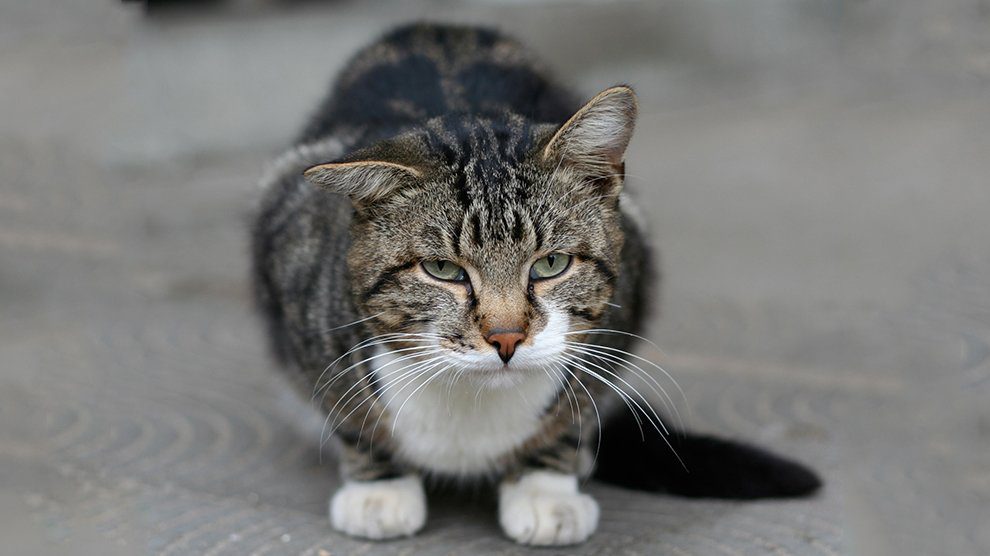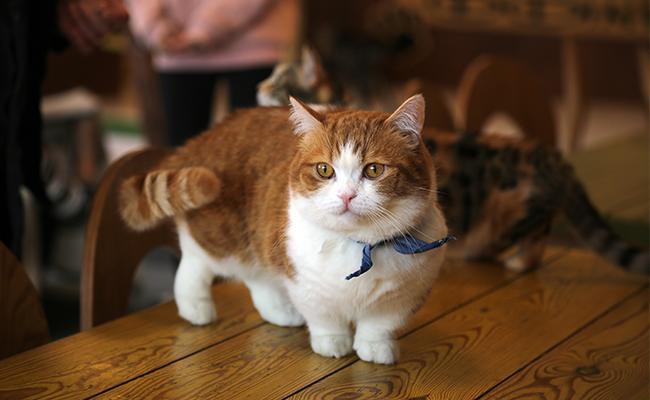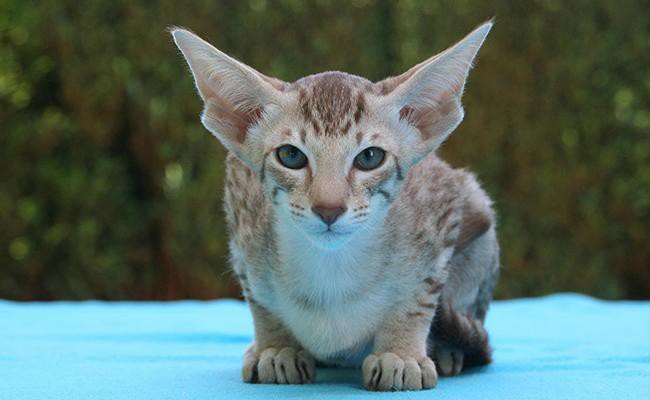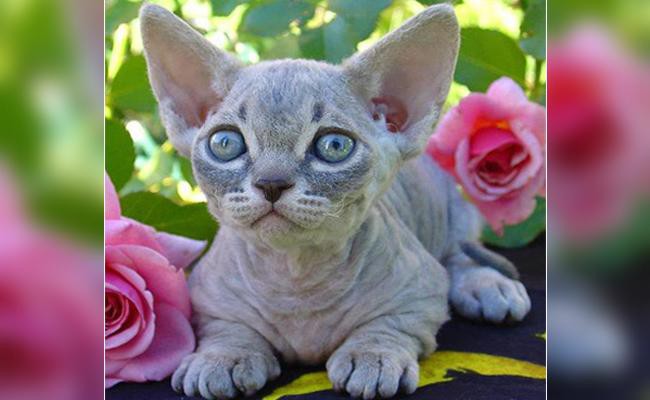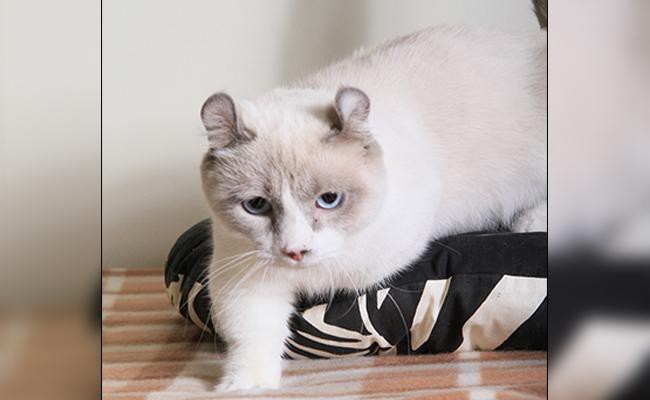Cat Pregnancy Calculator And Timeline
Considered a rare breed, cats with short legs are popular since the previous century. Well-known as dwarf cats, these cats are known for their short legs. Although these cats are short in size, they cannot be called miniature cats.
That being said, there are numerous dwarf cat breeds in existence at present, and they are all as charismatic as they appear. Let us learn more about cats with short legs.
Munchkin Cat
- Native – United States
- Life expectancy – 12 to 14 years
- Size – Small to medium
- Weight – Female Munchkin- 4 to 8 lbs; Male Munchkin- 6 to 9 lbs
- Height – 7 to 8 inches
- Coat and color – Longhaired and shorthaired with a semi-long silky coat or medium-length plush respectively coat
- Talkativeness – Normal
- Grooming pattern – Weekly once
- Attention requirement – High
- Activity level – High
Munchkin Cat Appearance
The Munchkin cat appears medium shaped along with triangular ears, walnut-shaped eyes, and a long-form. Also, munchkin cats feature a stubby and short leg, which remains one of the most recognizable characteristics.
The Munchkin cat consists of well-sized forelegs and is never bothered by its short legs. Moreover, the cat appears in both longhaired and shorthaired varieties.
Munchkin Cat Coat and Color
They are usually longhaired or short-haired with a silky coat or plush length coat and consist of various color patterns and combinations.
Munchkin Cat Grooming
The munchkins require regular grooming. Longhaired cats need a brush at least thrice a week, and shorthaired ones require a brush weekly once.
Furthermore, frequent brushing stops matting, hairballs, and shedding. Likewise, you must regularly trim your cat’s nails.
Munchkin Cat Temperament
This is a typical outgoing cat breed and much more agile and faster than it appears. Also, the people-friendly Munchkin prefers playing with other dogs and cats, and children.
These cats are often referred to as “ferret-like,” as they play, chase, and run with toys. While sitting up, they assume a “rabbit-like” posture, a feature that gave this cat the name “Stalingrad Kangaroo Cat.”
Not to mention, munchkins are also bred to a large number of domestic cats, and hence an individual cat’s trait and behavior are based on its appearance.
Munchkin Cat Health Problems
However, like other normal cats, a munchkin cat is prone to these disorders-
1. Lymphosarcoma
This is a common type of cancer that occurs in the lymphocytes. Important factors in keeping the immune system healthy, lymphocytes are an integral part of the cat’s overall well-being.
Especially, lymphoma causes around 33 percent and 90 percent of all tumors and blood cancers in cats.
2. Feline Lower Urinary Tract Disease (FLUTD)
This condition describes a different type of factors that damage the urethra and the bladder. Moreover, cats suffering from FLUTD exhibit pain and difficulty when passing urine and the presence of blood.
Mostly, FLUTD can happen at any age and is usually seen in overweight and middle-aged cats.
Signs of FLUTD
The common signs of FLUTD in cats include –
- The appearance of blood in the urine
- Passing urine outside the crate
- Licking the private area excessively
- Expressing a shrill while urinating
Causes of FLUTD
One of the leading causes includes uroliths or kidney stones in the urethra or bladder area.
Overall, factors including abrupt changes, multi-cat households, environment, and emotional stress in daily routine can also increase the susceptibility of FLUTD.
Treatment
Since FLUTD consists of different causes, it is quite challenging to provide a fixed treatment. However, depending on the cat’s signs, the vet will perform a series of tests ranging from a blood test, urine culture, and urinalysis.
Other common disorders associated with Munchkins include
- Uremia
- Pancreatitis
- Hyperthyroidism
Munchkin Cat Nutrition and diet
For these cat breeds, wet food nutrition is often regarded best, but at the same time, one can also give dry food. It is better to discuss cat food with the local vet if the cat suffers from obesity or diabetes.
Munchkin Cat Interesting Facts
- These cats are named munchkins presumably after the classic “ The Wizard of Oz’s” cats.
- In 1991, the Munchkin cat became a household name when it was introduced via a TV show.
- Lilliput is the world’s shortest living Munchkin cat. It stands around 5.25 inches tall.
- In general, munchkins appear in different types of colors, patterns, and shades.
Bambino Cat
- Native – United States
- Life expectancy – 12 + years
- Size – Small to medium
- Weight – 5 to 9 lbs
- Height – 7 to 8 inches
- Coat and color – Furry down/hairless
- Talkativeness – Average
- Grooming pattern – Regular
- Attention requirement – Normal
- Activity level – High
Bambino Appearance
This cat resembles a newborn, and many are entirely bald. In case the cat has some hair, the Bambino’s hair looks downy fluff and very light.
Bambinos are a result of some good recent crossbreeding.
Generally speaking, Bambino litters consist of short-legged kittens, and the very short legs are genetically drawn from the Munchkin. These cats have quite big ears.
Also, these cats inherited their no hair coat with white or pink skin from the Sphynx.
Bambino Coat and Color
Although they appear hairless, Bambinos are mostly covered with a fine, short down. The Bambino’s wrinkle appears like chamois to the human touch.
Bambino Grooming
Also, frequent grooming is advised to reduce or remove sebaceous secretions. Moreover, weekly baths are advised. When bathing and grooming are not continued regularly, these cats can develop skin infections.
Bambino Temperament
They are very affectionate, intelligent, and friendly. These cats love to be cuddled and handled, and Bambinos move along well with kids and other pets.
Overall, Bambinos are very adaptable and adjust quite well to new environments.
Bambino Health Problems
Bambinos are a new breed, and more studies are required to confirm absence or patience for possible health issues. Let us understand the health issues faced by its parents.
1. Sphynx Cat Health Issues
Some of the health issues faced by Sphynx cats include-
- Heart disease
- Build up of nasty skin conditions due to oil clogging on their skin
- They are also prone to periodontal disease, which means their teeth require regular maintenance.
2. Munchkin Cat Health Issues
The shortened limbs are directly inherited from the Munchkins. This genetic mutation is known as pseudoachondroplasia, and the Bambinos are unable to run fast or jump as high as the other cat breeds.
Therefore, the chances are that hairless bambino cats will mostly suffer from their parent’s conditions.
Bambino Nutrition and Diet
Bambinos require a high intake of meat for protein and fat. Also, these cats are not too fond of carbs. In the long run, Bambinos are known to develop diabetes if they consume only a carb-rich diet.
Bambino Interesting Facts
- Bambinos produce both long-legged and short-legged kittens.
- In addition, these cat breeds produce furry and hairless kittens as well.
- Also, they are accepted in the REFR or Rare and Exotic Feline Registry.
- The TICA also recognizes Bambinos as a new and experimental breed.
Dwelf Cat
Dwelf Cat Appearance
Dwelf cats are curl-eared, short-legged, and hairless cats derived from Munchkin, American Curl, and Sphynx. These cats have well-rounded abdomens and have short, powerful legs.
The front legs of Dwelf cats are generally bowed in shape.
Also, the Dwelf cat has a long, slender tail and flaccid hair on the top. Their heads are long, and these cats have prominent cheekbones. With almond-shaped eyes and large flexible ears, the Dwelfs are known for their stocky, small appearance.
- Native – United States
- Life expectancy –8 to 12 years
- Size – Small to medium
- Weight – 4 – 7 lbs
- Height – 6 to 7 inches
- Coat and color – Hairlessness and very short; skin color, at times with black
- Talkativeness – High
- Grooming pattern –High
- Attention requirement – Normal
- Activity level – Normal
Dwelf Cat Coat and color
The coat stretches from short downy hair to complete hairlessness. At times, eyebrows and whiskers may be very short or absent. They feel like suede, chamois, warm, and soft.
In particular, wrinkles on the forehead, shoulders, and legs are preferred. Since this cat breed appears hairless, these kitties are either black or natural skin color.
Overall, the Dwelf cat also consists of darker markings.
Dwelf Cat Grooming
Being medium to very high maintenance cat, they require timely bathing to preserve their skin supple, clean, and soft. Not to mention, these cats produce excessive wax and require regular cleaning.
Also, Dwelf cats require claw trimming once every fortnight.
Dwelf Cat Temperament
Dwelf cats love their humans and are adjustable to being handled. In fact, Dwelf cats are playful, active, friendly, and sociable. Moreover, the short legs of Dwelf cats do not prevent them in any way.
Other than that, climbing is definitely not a problem because they will find new inventive ways of climbing onto cupboards and beds.
Dwelf Cat Health Problems
As they are new breeds, it is quite challenging to mention any prominent health issues. However, at present, it appears that this breed of cat looks healthy and robust. There can be genetic issues associated with this cat.
They include
- Pectus excavatum ( a deformity that produces a sunken chest and funnel chest)
- Lordosis (inward bending of the spine)
All in all, these traits can be ‘bred-out’ in case a well-planned breeding schedule is strictly followed.
Dwelf Cat Nutrition and diet
In general, hairless cats like the Dwelf require a rich calorie intake. Therefore, feed them with good commercial cat food and, if required to contact the vet for a daily feeding plan.
Dwelf Cat Interesting Facts
- The Dwelf is a hairless and curious looking breed known for its dwarf-like body and elf-like features.
- Like their Bambino counterparts, these cats also retain their appearance and kitten attitude.
- An exotic breed like the Dwelf is a cat for all open-minded cat lovers.
- In particular, the characteristics of these cats are almost next to impossible to ignore.
Minskin Cat
- Native – United States
- Life expectancy –12 to 14 years
- Size – Small
- Weight – 4 – 6 lbs
- Height – 7 to 8 inches
- Coat and color – Sparse hair, in all patterns and colors
- Talkativeness – Low
- Grooming pattern –High
- Attention requirement – Normal
- Activity level – Normal
Minskin Appearance
These cats have very short legs. The fur appears only at certain places, including the face, ears, nose, legs, and tail. Significantly, the belly looks hairless, and only sparse hair appears all over the body.
Moreover, when Minskin has fur, it resembles the most delicate silk fabric.
This cat features a semi-cobby body, a stocky body, and looks low to the floor. With big eyes, rounded heads, large ears, this cat’s facial appearance looks comical.
Minskin Coat and Color
All points and coat colors are accepted. Thus, a Minskin cat may have the color of a tabby or a Siamese.
Minskin Grooming
The Minskins require frequent bathing. This stops the oil buildup in their skin. Also, this breed enjoys minimal shedding.
Like other hairless cat breeds, Minskins need protection from the sun’s rays.
In winter, these cats love wearing sweaters to keep themselves warm.
Minskin Temperament
They are very friendly, loving, and cuddly cats. Being very affectionate, Minskins are known to move with other pets as well. Very intelligent, the Minskins are an entertaining and friendly companion.
Overall, these cats adjust suitably to new environments with ease. In addition, these cats display an endearing charm to communicate their needs. Besides, although Minskins are silent, they quickly make their intentions clear.
Minskin Health Problems
These breeds are prone to common health problems handled by most cats. In general, the hairless skin of the Minskins can develop yeast infections.
Overall, lordosis or pectus excavatum are seen in these cat breeds. Cats should be vaccinated to prevent them from contracting deadly diseases.
Minskin Nutrition and Diet
They require fresh, clean water and good quality homemade or commercial cat food. Also, these cats love milk and contact the vet if the cat suffers from lactose intolerance.
Minskin Interesting Facts
- Minskins have a unique Boston connection.
- These cats have a susceptible coat.
- These cats trust everyone alike.
- The distinct visual appeal of the Minskins makes them a sitting target for abduction.
- Overall, they love snuggling with humans.
Kinkalow Cat
- Native – United States
- Life expectancy – 12 to 15 years
- Size – Small
- Weight – 3 – 7 lbs
- Height – 7 to 8 inches
- Coat and color – Short to long
- Talkativeness –Average
- Grooming pattern – Weekly once
- Attention requirement – Normal
- Activity level – Normal to high
Kinkalow Cat Appearance
The Kinkalow is a crossbreed between the Munchkin and the American Curl. Due to its Munchkin parent, these cats are short.
Moreover, when a Kinkalow cat is born, they mostly contain straight ears. However, later, the ears curl and turn crescent-shaped.
Kinkalow Cat Coat and colors
They have a short or long fur coat. Moreover, this appears relatively sleek and smooth and in different patterns and colors.
Kinkalow Cat Grooming
These cats require very little grooming and weekly once the maintenance is sufficient.
Kinkalow Cat Temperament
They behave silly and mischievous like the Munchkins. At times, the Kinkalows behave like dogs, and these cats will follow the ower wherever the owners go.
In addition, the Kinkalows carry a mystical and a strange look. This cat breed survives longer than their counterparts.
Overall, they are full of energy, crazy, wild, and loving.
Kinkalow Cat Health Problems
As a matter of fact, these cats are quite robust, and they usually do not suffer from any health issues. Usually, if they are enduring because of any health problem, it would have been through genetic inheritance.
Kinkalow Cat Nutrition and Diet
These cats do not require anything special. So, it is better to feed this cat with regular cat food. As such, the Kinkalows are subject to obesity and if noticed to be overweight, kindly balance the cat’s diet suitably.
Kinkalow Cat Interesting Facts
- Bear in mind, not all these cats are seen with curled ears. In reality, they carry this gene and can transfer it to the next generation.
- In terms of behavior, these cats are curious and playful without being hyperactive.
- They are considered an experimental cat breed.
- In particular, the Kinkalow cats are highly energetic and will use their short legs for climbing any surface.
Lambkin Cat
Lambkin Appearance
Lambkins are a crossbreed between the famous Selkirk Rex and Munchkin cat. This cat consists of a small to the medium-sized body.
In general, it will mainly have short legs from the Munchkin or crinkled coat from the Rex cat. Moreover, both these breeds contribute to the appearance of the Lambkin.
However, the visual appeal of this cat depends upon its parents inherited traits.
- Native – United States
- Life expectancy – 12 to 14 years
- Size – Small
- Weight – 4 – 9 lbs
- Height – 7 to 8 inches
- Coat and color – Longhair, curly, and all colors
- Talkativeness –Average
- Grooming pattern – Weekly
- Attention requirement – Normal
- Activity level – Average
Lambkin Coat and Color
Since the Lambkin cat attracts curly hair, it is necessary to take care of its coat.
Lambkin Grooming
In general, Rex Fur appears quite fragile and easily prone to breaking. Also, brushing too hard damages the coat of this cat.
Moreover, the owners need to be assured of a lambkin cat getting a regular bath in order to prevent the clogging of oils.
Overall, the exact level of grooming depends on their coat’s nature, but they require regular health and maintenance.
Lambkin Temperament
These cats inherit the sweet-natured personalities of their ancestors. Lambkin cats love petting and physical contact.
In addition, breeders agree that the small size these cats inherit does not prevent them from chasing or leaping as another breed would.
Lambkin Health Problems
As a matter of fact, cats are not short-legged by nature. Also, the short legs are produced by a disorder known as achondroplasia.
Not to mention, there is some disagreement over whether or not the Lambkin suffers from discomfort or health issues. Furthermore, a research study is presently in progress to decide the result of dwarfism. However, as we learn more about these cats, the owners are advised to contact the local vet.
Lambkin Nutrition and Diet
These cats love meat-based food items. However, contact the local vet for a customized diet plan for the cat.
Lambkin Interesting Facts
- Regarded as one of the world’s rarest breeds, the Lambkins are also called Nanus Rex.
- In general, these kittens are usually neutered and cannot take part in shows.
- This breed is officially recognized by the TDCA (The Dwarf Cat Association) and the TICA (The International Cat Association).
- The Lambkin cat resembles a “young lamb,” justifying its name.
Skookum Cat
- Native – United States
- Life expectancy – 10 to 15 years
- Size – Small
- Weight – 4 – 9 lbs
- Height – 7 to 8 inches
- Coat and color – Short to long
- Talkativeness –Average
- Grooming pattern – Weekly once
- Attention requirement – Normal
- Activity level – Normal to high
Skookum Cats Appearance
Being a crossbreed between the Munchkin and LaPerm cat, Skookums are easily identified by their curly coat and short legs.
These cats have shorter bones than the other breeds. These cats are also famous for their stocky and short bodies. Also, Skookums have shorter front legs compared to their hind legs.
This stature makes this cat stay lower to the floor. These kitties consist of a wedge-shaped head, large, broad ears, and walnut-shaped eyes.
Finally, the neck and the body will appear broad, and the chest also looks rounded.
Skookum Cats Coat and color
Another essential feature of this cat is its curly coat. They appear short or long and feature a soft texture.
This cat’s coat can consist of different colors and patterns, including colorpoint, solid, and bicolor.
Skookum Cats Grooming
The maintenance of Skookum cats is quite simple. These cats love pampering and the fur texture actually looks easy for grooming.
Therefore, in order to maintain your cat’s coat fabulous and dashing, you can easily clean it at least twice a week.
Skookum Cats Temperament
Skookums are sweet and affectionate. Moreover, these cats are playful, outgoing, and curious. Indeed, Skookums are self-assured and confident, and they love climbing and jumping.
These cats follow a strange practice- to hide objects in different places.
Skookum Cats Health Problems
Generally speaking, the Skookum does not suffer from any significant illness as such. However, if you wish to adopt one, ensure the cat comes from a reputable breeder and carries a health certificate.
Skookum Cats Nutrition and Diet
A well balanced, good cat food is necessary for the overall health of the cat. Moreover, the owner needs to ensure that the cat has easy access to fresh drinking water 24/7.
Skookum Cats Interesting Facts
- The name “Skookum” comes from the Chinook Native American language, meaning powerful, great, or strong.
- They have a unique tail, tapering at the base and appearing pom-pom.
- Created by Galusha in the early 90s, the Skookum is a popular breed by many European registries.
- In countries like Australia, this breed is accepted as a regular show cat.
Napolean Cat
- Native – United States
- Life expectancy – 9 to 15 years
- Size – Small
- Weight – 5 – 9 lbs
- Height – 7 to 8 inches
- Coat and color – Short to long
- Talkativeness –Average
- Grooming pattern – Weekly once
- Attention requirement – Normal
- Activity level – Normal to high
Napolean Cat Appearance
This cat is the result of a successful crossbreeding between a Persian and the Munchkin cat. Known as “baby doll face,” these cats appear long-legged as well as short-legged.
In fact, they are not hairy Munchkin or short-legged ones like Persian; this cat is considered the best of both worlds. Overall, the Napoleon cat features a strong, muscular, and firm body.
Napolean Cat Coat and Colors
When you handle a cat, you will quickly notice that their fur appears plush and luxurious. In the case of a shorter coat, they appear soft and dense.
On the contrary, the longer coat is thick, soft, straight, and with soft hair. A Napoleon cat can show a different range of patterns and colors.
Napolean Cat Grooming
They need a medium level of grooming. Furthermore, the grooming is based on the cat’s coat texture. Depending on the coat’s size, cats with longer coats need grooming twice a week, and cats with shorter coats need brushing once a week.
Napolean Cat Temperament
The petite Napoleon suits anyone who is searching for a sweet, easygoing pet. Furthermore, even families with small children will love the company of these cats.
Napoleon cats feature a warm, friendly, and social behavior. Also, these cats do not like to be left alone, and they enjoy human companionship.
Overall, a Napoleon cat is known for its gentle, people-friendly, and affectionate behavior.
Napolean Cat Health Problems
You should ensure that the cat is bought from a recognized breeder. In general, Napoleon cats are susceptible to diseases, including Polycystic Kidney Disease or PKD.
Grooming their coat at least once a week prevents matting of the fur.
Other health issues include
- Lysosomal accumulation neuropathy
- Peritoneopericardial defect
- Photophobia
- Cataracts
Napolean Cat Nutrition and Diet
One can choose from dry, canned, or raw cat food. Primarily, provide fresh drinking water to the cat, and milk should be provided only as a reward.
Napolean Cat Interesting Facts
- Joe Smith created the cute Napoleon cat.
- The breed came into existence in 1996. Joe Smith named it Napoleon, after the French Emperor who was famous for his short figure.

